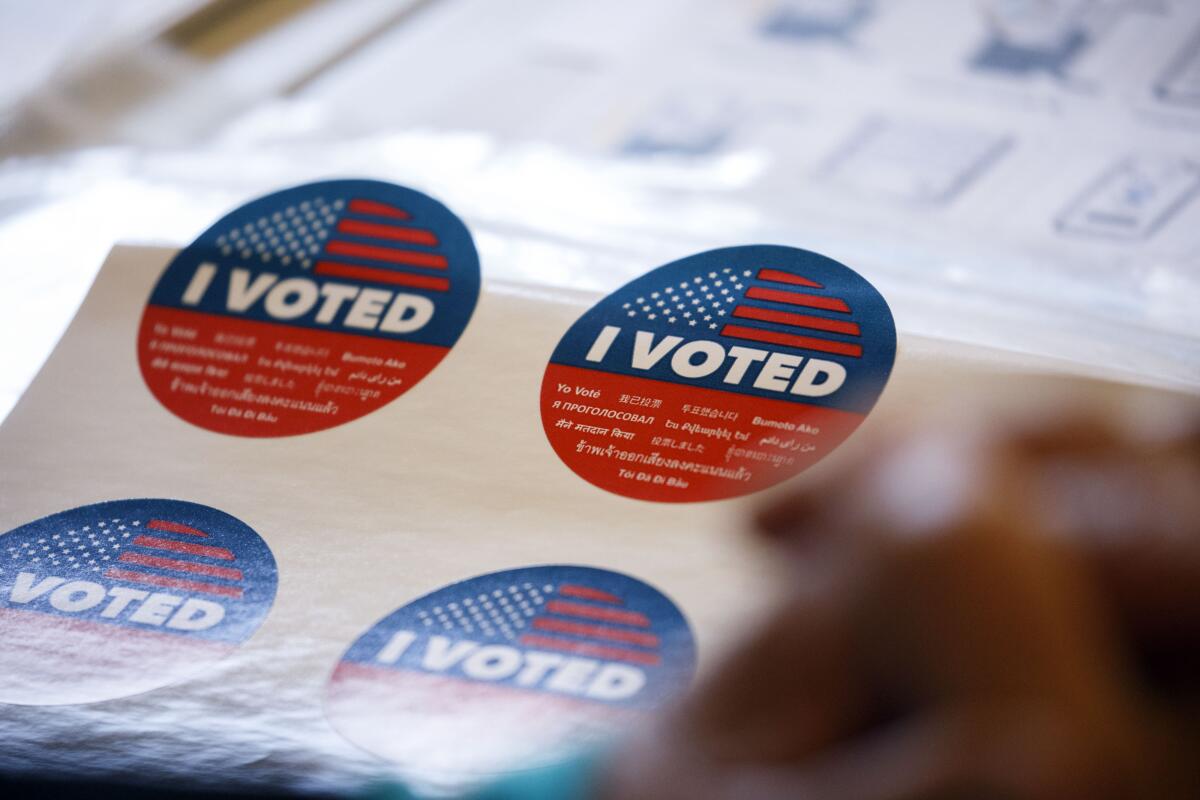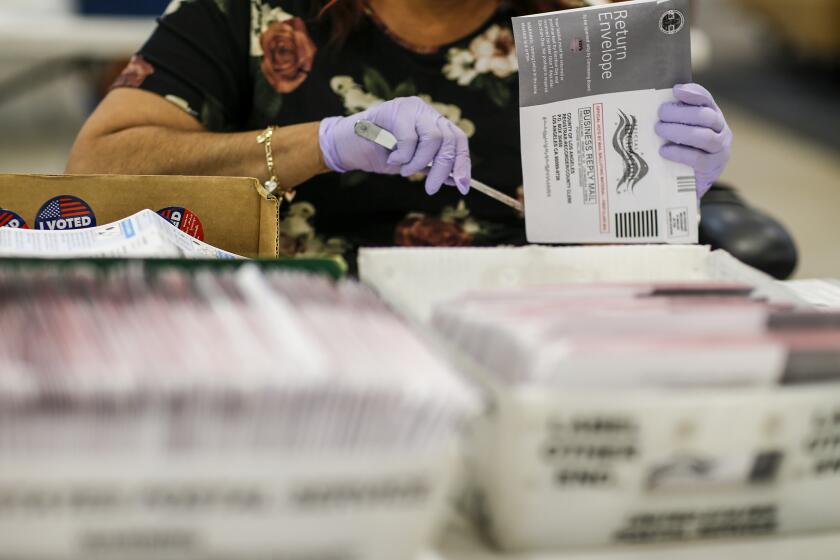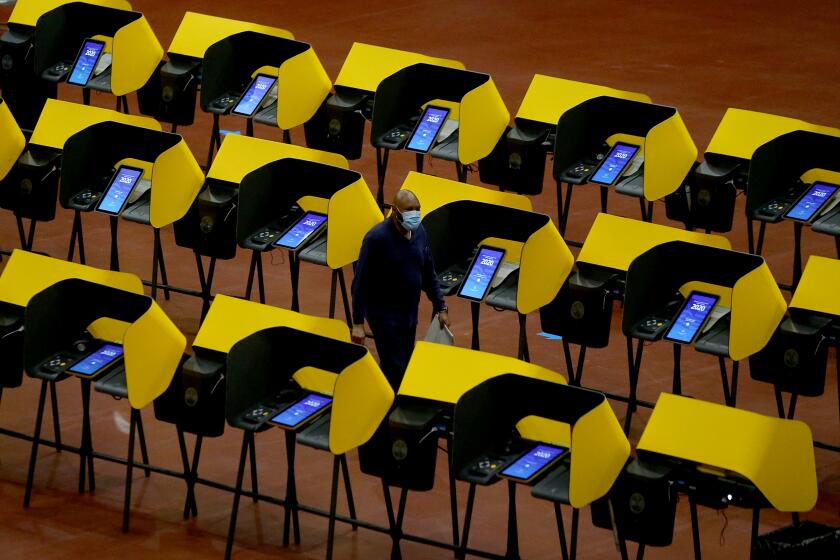What is a midterm election? And what are the stakes in 2022?

- Share via
This November’s elections are called “midterms” for a good reason: We’re about halfway into the four-year term President Biden won in 2020.
The results will determine whether Biden has a supportive Congress or a hostile one for the next two years. Yet it’s worth remembering that far more state and local races are on the Nov. 8 ballot than national ones.
The U.S. Constitution sets up the midterm dynamic by requiring every member of the U.S. House of Representatives and about a third of the U.S. Senate to run for office halfway between presidential elections. House members serve for two years and senators for six (with their terms staggered, so no more than 34 of the 100 senate seats are up for election at a time); the president serves for four.
Then in 1875, Congress emphasized the national ramifications of these contests by requiring all states to decide House races simultaneously. Under federal law, Election Day for House members is the Tuesday after the first Monday in November in even-numbered years.
Because so many seats are up for grabs, each biannual election determines which party controls the House and the Senate. That’s why, from the perspective of national politics, the midterm elections act as a broad gauge of the president’s popularity — a midterm grade, if you will.
Granted, when people step into the voting booth on Nov. 8 (or more commonly in California, fill out their mail-in ballots), they won’t cast a vote for or against Biden. They’ll choose between specific candidates whom they may like or dislike more strongly than the guy in the White House.
Statewide offices, congressional seats, L.A. mayor, propositions — including on abortion, sports betting and taxes — are up in the November election.
Historically, though, voters have used midterm elections to send more members of the opposition party to Congress, reflecting their state of near constant disappointment with Washington. Since the Civil War, rarely has the party holding the White House gained seats in the House or Senate in a midterm, and when it does, it’s often because of some remarkable, galvanizing event — such as the Sept. 11, 2001, terrorist attacks or the impeachment of President Clinton in 1998.
As noted above, these elections are midterms only from the perspective of national politics. But “local and state races don’t happen in a vacuum, so national political events can have an immense impact,” said Dan Schnur, who teaches political communication at USC and UC Berkeley.
The linkage is to some degree deliberate. Angelenos voted in 2015 to shift local elections from odd- to even-numbered years so they would coincide with presidential and midterm elections, hoping to increase the anemic turnout in those contests. How anemic, you ask? In the L.A. mayoral election in 2017, only 20% of registered voters cast a ballot. In the primary this year, that number rose to roughly 30%.
California’s November election will feature seven statewide ballot measures.
In addition to boosting turnout, putting local and national elections on the same ballot made it more likely that national issues would color local races, Schnur said in an interview, adding, “My own feeling is that happens anyway.
“It’s not like voters have separate levels of consciousness for different levels of politics,” Schnur said. “They’re happy or unhappy about public safety or homelessness or healthcare or climate change, and they’re looking for candidates who are talking to their concerns.”
In an era of social media and online news feeds, the adage that “all politics are local” may no longer hold. Voters are more exposed to national news and national issues, and they want each level of government to respond to them, Schnur said. “We want our congressional representatives to do something about homelessness and climate change, but we want our governor and our mayor to do something too.”
California is one of 36 states (and three U.S. territories) that elect governors this year, compared with nine states that hold gubernatorial elections during presidential election years. The other five hold their elections in odd-numbered years.
Homelessness, housing, crime: A guide to issues dominating 2022 L.A elections
And as anyone who watches local television in Los Angeles knows by now, November‘s voters also will pick a new city mayor. The advertising blitz by candidates Rick Caruso and Rep. Karen Bass (D-Los Angeles) made that race impossible to ignore. More than 70 California cities, and dozens of others around the country, will elect mayors that day.
Beyond that, Californians will elect the other seven state constitutional officers (that is, the other officials elected statewide to lead state offices, such as the state attorney general and treasurer), along with every member of the state Assembly and half the members of the state Senate.
But wait, there’s more! In addition to mayor, voters in the city will decide the fates of four City Council runoff elections. Across the county, the sheriff’s race and one of the five spots on the Board of Supervisors also will go to a runoff on Nov. 8, as well as two of the seven seats on the Los Angeles Unified School District board and a vast number of other municipal and regional elections, including water boards, school boards and city councils.
Oh and yes, there will be ballot measures aplenty, including propositions related to sports betting, abortion, tobacco sales and affordable housing.
About The Times Utility Journalism Team
This article is from The Times’ Utility Journalism Team. Our mission is to be essential to the lives of Southern Californians by publishing information that solves problems, answers questions and helps with decision making. We serve audiences in and around Los Angeles — including current Times subscribers and diverse communities that haven’t historically had their needs met by our coverage.
How can we be useful to you and your community? Email utility (at) latimes.com or one of our journalists: Jon Healey, Ada Tseng, Jessica Roy and Karen Garcia.
More to Read
Get the L.A. Times Politics newsletter
Deeply reported insights into legislation, politics and policy from Sacramento, Washington and beyond. In your inbox twice per week.
You may occasionally receive promotional content from the Los Angeles Times.













